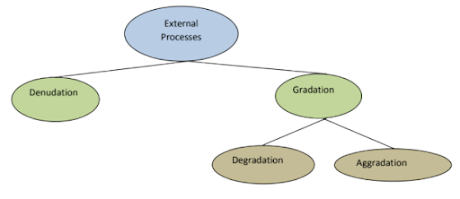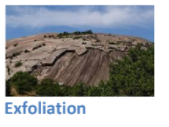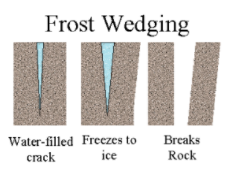ICSE Revision Notes for Weathering Class 9 Geography
Chapter Name | Weathering and Denudation |
Topics Covered |
|
Related Study |
Weathering
External forces acting on the surface of the Earth are known as exogenic forces. Wind, water and ice are some exogenic forces. These forces cause various processes such as erosion, transport, deposition and mass wasting.
Denudation and Gradation
The external processes acting on the surface of the Earth are divided into two categories. These are:
- Denudation: Wearing away of landmasses by processes such as weathering, erosion, transport and mass movements is known as denudation. Water, wind and glaciers are main agents of denudation.
- Gradation: Levelling of land because of the combined processes of erosion and deposition is known as gradation. Rivers, glaciers, winds and sea waves are the agents of gradation. The process of gradation can be divided into degradation and aggradation.
- Degradation: Degradation refers to the wearing away or lowering the land surface by erosion.
- Aggradation: In this process, the landforms are elevated because of the deposition of various transported materials such as fragments of rocks by exogenic forces like river water.
Rocks have to undergo the process of weathering for erosion to occur. During the process of erosion, rocks are worn down by moving water and ice glaciers. Eroded materials are transported and deposited in low lands. Thus, these processes of denudation, gradation, degradation and aggradation are interactive and interdependent.
Weathering is the gradual wearing and tearing of rocks on the surface of the Earth. The main agents of weathering are temperature, humidity and precipitation.
Main characteristics of weathering:
- Weathering is the wearing away or the disintegration of rocks.
- This process includes the breaking down and not the removal of rocks from the surface of the Earth.
- One of the most important results of weathering is soil formation.
- Rocks break into stones, pebbles and eventually fine particles, which get transported by the agents of gradation such as wind and water.
- It depends on climatic conditions. For example, in dry climate, mechanical weathering is very common.
- The nature of rock (texture, composition and hardness) also affects the process of weathering.
- Weathering is of three types: mechanical, chemical and biological.
Types of Weathering
1. Mechanical Weathering
It is also known as physical weathering. The disintegration of rocks without any change in their chemical composition is known as mechanical weathering. Moisture, changes in temperature, frost action and winds are the main actors of mechanical weathering. This kind of weathering usually occurs in hot deserts because of the wide ranges of temperature.
There are four types of mechanical weathering:
- Block Disintegration: Rocks disintegrate because of repeated expansion (due to high temperature) and contraction (due to extremely low temperature).
- Granular Disintegration: Agents of weathering reduce the rocks made of different minerals to small pieces and fragments.
- Exfoliation: Sudden change in temperature may cause cracks and fissures in rocks. Weathering occurs when water percolates in these fissures. The sudden expansion and contraction of rocks result in the peeling of their outer layers or exfoliation.
- Frost Action: In regions of dry climate, the cracks in rocks get filled with water. During the night, the water freezes and expands. When this process is repeated several times, the rock eventually breaks.
2. Chemical Weathering
Minerals present in rocks undergo changes because of the action of water, oxygen and other organic acids. Thus, rocks get decomposed because of chemical weathering. This happens because of chemical reactions which occur in rocks when these agents come into contact with the surface of rocks.
There are four types of chemical weathering:
- Solution
• Minerals present in rocks get dissolved in water. The rate at which the solution of rocks takes place is subject to the chemical composition and the structure of rocks.
For example, rainwater causes chemical disintegration of gypsum. - Carbonation
• Many rocks contain constituents which have carbon dioxide present in them. When it comes in contact with water, acidic effect on rocks are produced.
• Many rocks such as marble and limestone get dissolved in water. Rainwater converts carbonate into calcium bicarbonate which is soluble and hence dissolves in water. - Oxidation
• Minerals present in rocks react with oxygen present in the atmosphere. Rainwater also involves atmospheric oxygen.
• When rainwater comes into contact with the iron compounds in rocks, iron begins to rust. This may also change the colour of the rocks to red, brown or yellow. - Hydration
• Minerals present in rocks expand on coming into contact with rainwater.
• The minerals become heavy and begin to break down. Rocks such as feldspar get converted to kaolin.
Differences between Mechanical and Chemical Weathering:
|
Mechanical Weathering |
Chemical Weathering |
|
Rocks disintegrate without any change in their chemical composition. |
Chemical composition of rocks gets changed because the minerals present in rocks get dissolved. |
|
It takes place in extremely hot regions and dry climatic conditions because the temperature in such regions varies during the days and nights. |
It takes place in hot and humid regions. |
|
Main agents of weathering are temperature, weathering and moisture. |
Main agents of weathering are oxidation, solution, carbonation and hydration. |
|
Rocks are affected to great depths. |
It mostly takes place near the surface of the Earth. |
Biological weathering is also known as organic weathering. Animals, insects, plants and humans are the main agents of this type of weathering. This is because all the organic or biological matter is made of oxygen and water which may lead to chemical reactions in rocks, resulting in their decomposition and physical disintegration.
Biological weathering occurs in the following ways:
- Burrowing animals such as rodents and moles loosen the ground or surface materials resulting in their physical disintegration. When animals die, their decaying bodies release chemicals which also lead to the disintegration of rocks.
- Vegetation: Rocks may disintegrate when the roots of trees reach deep into them. However, trees may also prevent disintegration of rocks by protecting them from direct exposure to sunlight and wind.
- Humans: Humans are the most active agents of physical and chemical weathering. Mining, construction of roads and buildings, agriculture and dumping of chemicals lead to both physical and chemical disintegration.
Weathering in different Climatic Regions
Equatorial regions experience hot and humid climate. Chemical weathering is more common in these regions because of the presence of high temperature and humidity.
Tropical regions have separate dry and wet seasons. High temperature increases the rate of evaporation. During the wet season, oxides of iron and aluminium are precipitated from rocks. This results in the formation of laterite soils.
In the regions of dry climate, such as in deserts, physical or mechanical weathering is common as temperatures in these regions are extremely high during the day time and drops considerably in the nights.
In temperate and mid-latitude regions, frost action and chemical weathering occur in areas which have a high concentration of limestone rocks.
In the polar regions, frost action is the common form of weathering as the temperature is extremely low. Because the melting water in these regions contains carbonic acid, chemical weathering may also be experienced.
Mass Wasting
The large-scale movement of waste materials, derived from weathering of bedrock, down a slope is known as mass wasting or mass movement. Water, wind and glaciers are main agents of mass wasting. There is rapid movement of rocks on steep slopes. Mass movements can be classified into slow and rapid movements:
Slow Movements
- Slow movements can be further categorised into creep and solifluction.
- The slow downhill movement of debris is called soil creep. Fine weathered rock debris is known as soil creep, while unweathered blocks of rocks are known as rock creep.
- When water or wet soil forms clay and moves down the slope as a viscous liquid, it is called solifluction.
Rapid Movements
Four types of rapid movements are
- Landslides: This is the most common of all the mass movements. When the surface of the rock breaks off, the rock is displaced from its place and a heavy movement of rock and mud takes place. The downwards slope of the rock takes place in two main ways:
• Fall: Fragments of rocks fall through steep slopes.
• Slide: A rock along with mud comes down from a slope in a fixed path - Earth Flow: Fine-grained materials which have been saturated with water come down a slope because of the pull of gravity. Earth flow generally occurs in areas which have alluvial soils or are in hilly regions.
- Mud Flow: Water flows with many particles such as silt down a slope. In mudflow, the quantity of water is more than in Earth flow. It generally occurs in areas where vegetation is sparse and slopes are steep.
- Sheet Wash: The entire piece of land is covered with a thick layer of mud, soil and water. This occurs in the absence of natural vegetation. Many parts of the world have been affected because of sheet wash.
Mass wasting also creates various landforms. Landslides on the Himalayan hillslopes have created many lakes. Some other landforms created as a result of mass wasting are ripples, escarpments, terraces, meanders and scars.






